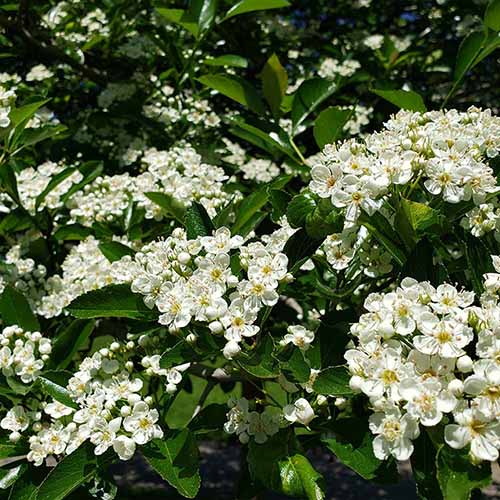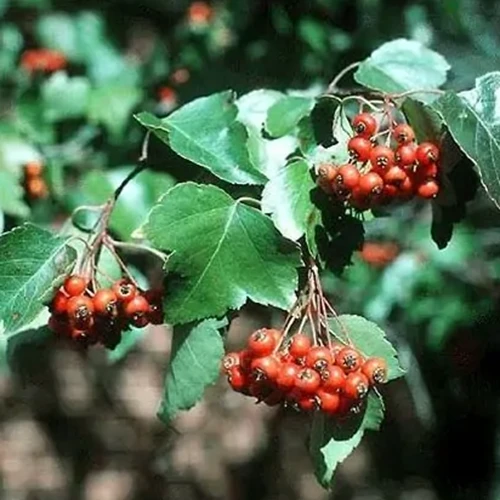Crataegus spp.
I distinctly remember my first close encounter with a hawthorn.
I was looking for the perfect pair of trees to hang my hammock between, in the backyard of my new house, and I spotted the right location between some small but sturdy flowering trees.
I started hanging up the hammock, dreaming of reading a book below the gentle hum of the bees feeding on the pretty white and pink blossoms, when I felt a searing pain in my arm.
It wasn’t a bee defending itself, but a vicious thorn tearing through my flesh.
And to me, that perfectly encapsulated the wonders and drawbacks of growing hawthorns. They’re beautiful, but they also have thorns that can grow several inches long.
It’s definitely a “look but don’t touch” kind of situation.
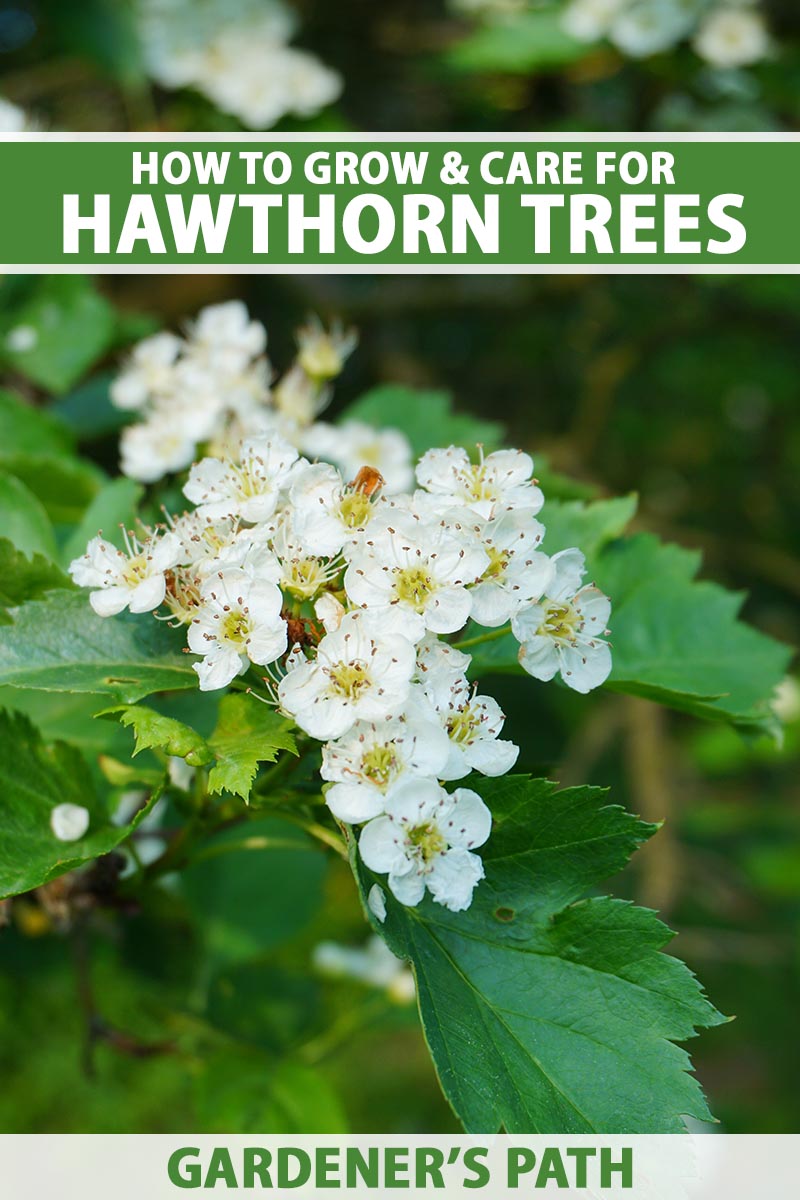
We link to vendors to help you find relevant products. If you buy from one of our links, we may earn a commission.
My painful first encounter aside, hawthorns are actually excellent to keep around.
They’re pollinator magnets, particularly for native bees, moths, and butterflies, and many people grow them in orchards to help improve pollination.
You can find thornless versions, by the way, and you can even use the thorned types to your advantage.
Then there are the blossoms. The flowers are pungently sweet-scented and extremely attractive – both to humans and animals. They look somewhat like apple blossoms, so if you’re a fan of those, you’ll love hawthorns.
The trees are also beloved nesting sites for birds. The thorns provide them with protection and the vibrant fall berries are a nourishing food source.
If you’ve ever witnessed cedar waxwings migrating through the area, they always stop and feed on a hawthorn tree before moving on.
The fruits of these apple and rose relatives are edible, and they resemble rose hips. You’ll just have to fight the birds for them.
Plus, the trees are long-lived, hardy, and pest and disease resistant.
If you were just dipping your toe into the waters of hawthorn growing, hopefully I’ve convinced you to dive straight in.
Here are all the things we’ll go over in this guide to get to know these fantastic trees better:
What You’ll Learn
Ready to make the pollinators and birds in your neighborhood extremely happy? Let’s start growing hawthorns!
What Are Hawthorns?
Crataegus is derived from “kratos,” meaning strength in Greek, a reference to the hard wood, and “akis,” meaning sharp tip, an accurate description if there ever was one.
There are nearly 300 species in the genus, with the majority being native to North America, but they also grow in Europe and Asia.
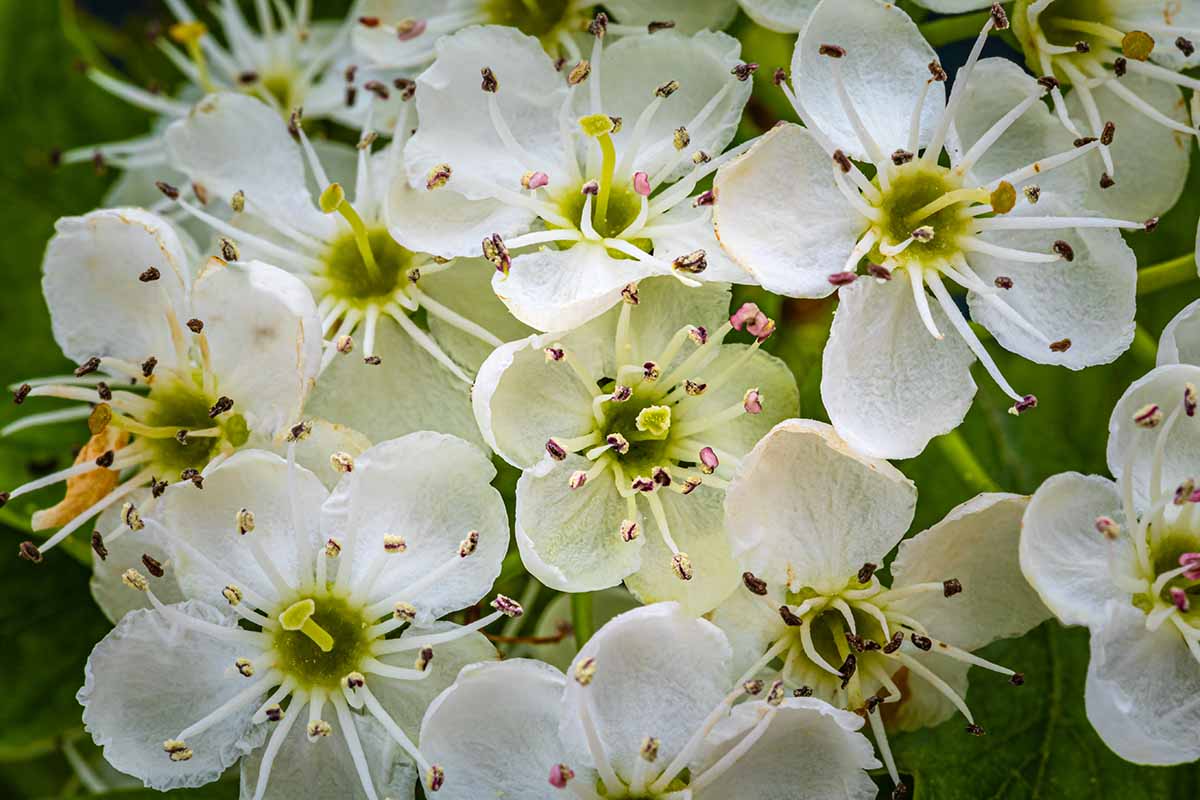
East of the Rockies, you’ll most frequently find:
- Anomalous (C. anomala)
- Arnold (C. arnoldiana)
- Beautiful (C. pulcherrima)
- Canadian (C. canadensis)
- Copenhagen (C. intricata)
- Dotted (C. punctata)
- Downy (C. mollis)
- Dwarf hawthorns (C. uniflora)
- Fireberry (C. chrysocarpa)
- Frosted (C. pruinosa)
- Kansas (C. coccinioides)
- Littlehip (C. spathulata)
- Mayhaw (C. aestivalis)
- Mink (C. dispessa)
- Parsley (C. marshallii)
- Pear (C. calpodendron)
- Pringle’s (C. pringlei)
- Quebec (C. submollis)
- Scarlet or Ontario (C. coccinea)
- Summer (C. flava)
- Washington (C. phaenopyrum)
In western North America, you’ll see:
- Black (C. douglasii)
- Castlegar (C. castlegarensis)
- Cerro (C. erythropoda)
- Cockspur (C. crus-galli)
- Columbia (C. columbiana)
- Enderby (C. enderbyensis)
- Fleshy (C. succulenta)
- Green (C. viridis)
- Gregg’s (C. greggiana)
- Large thorn (C. macracantha)
- Mexican (C. mexicana)
- Okanagan valley (C. okanaganensis)
- O’Kennon (C. okennonii)
- Phipp’s (C. phippsii)
- Piper’s (C. chrysocarpa var. piperi)
- Reverchon’s (C. reverchonii)
- River (C. rivularis)
- Riverflat or western mayhaw (C. opaca)
- Suksdorf’s (C. suksdorfii)
- Tracy’s (C. tracyi)
- Turner’s (C. turnerorum)
- Willow (C. saligna)
- Wooton hawthorns (C. wootoniana)
Now that you’ve learned all this taxonomy, go ahead and toss it out the window.
There are so many species and they hybridize so readily that, at least in the wild, you can never be sure exactly what you’re looking at as you hike by in the woods.
This sort of situation is known as being taxonomically unstable.
Not all types have thorns, such as the thornless cockspur (C. crus-galli var. inermis) and C. x mordenensis ‘Toba.’ Some have branched thorns on the trunk, as did the trees I tried to hang my hammock from, rather than just having single thorns on the branches.
Speaking of thorns, whereas roses technically have prickles, not thorns, hawthorns have true thorns. A thorn is defined as a modified stem with a sharp point.
The flowers are typically clustered in racemes of five, and each blossom has five petals. The flowers range from white to pink or red in color, with yellow, ivory, or pink anthers at the center.
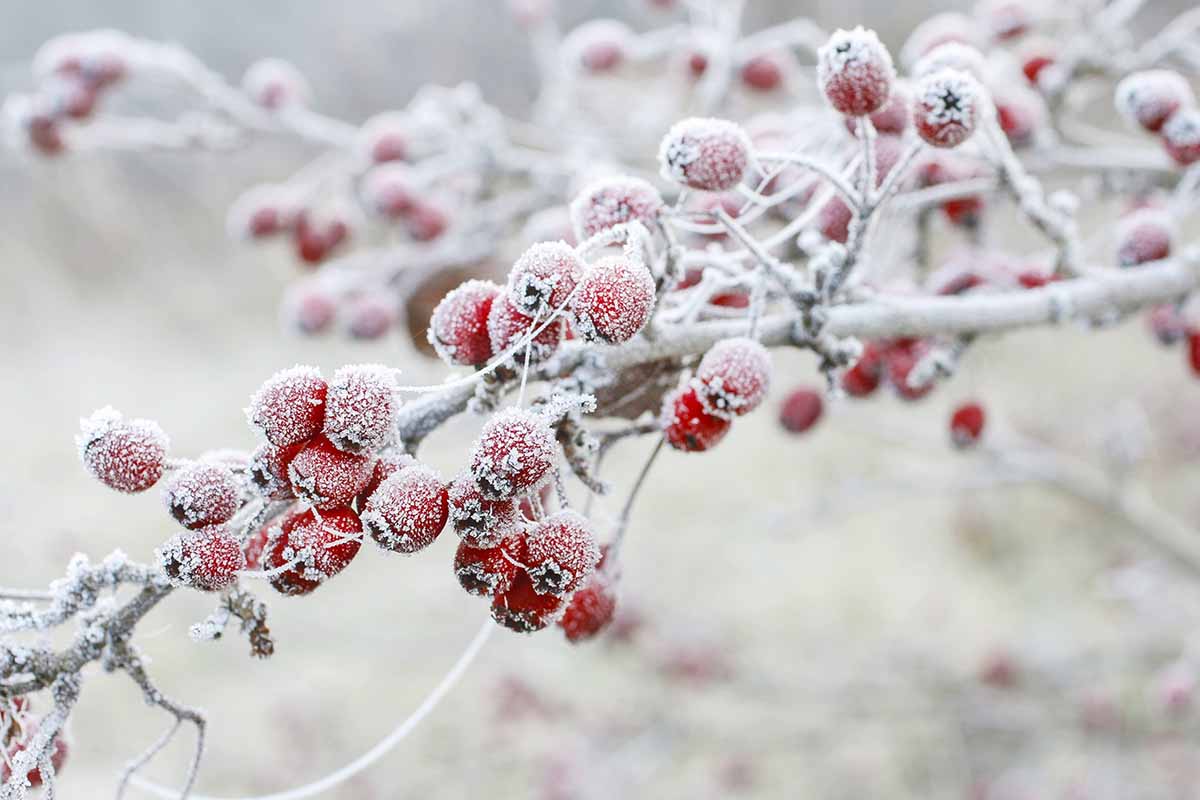
The fruit, which is technically a pome or drupe, can be pink, orange, red, purple, or nearly black when ripe.
It’s about the size of a blueberry, and the flesh has a mealy texture and a bitter flavor. You’ll sometimes see these referred to as berries.
Leaves are alternate and simple. They can have smooth or deeply divided margins, and everything in between.
The shape can vary quite a bit from ovate to triangular. In the fall, the foliage turns orange, red, and purple.

Most but not all varieties thrive along streams, in marshy areas, and in disturbed areas like roadsides, as well as meadows and woodlands. They’re incredibly adaptable.
Cultivation and History
Hawthorns have been in cultivation across the globe for centuries.
Recorded use of hawthorn as a medicinal ingredient dates back as early as the 1400s in Europe, and indigenous people in North America have been using foraged hawthorn since well before Europeans came calling.
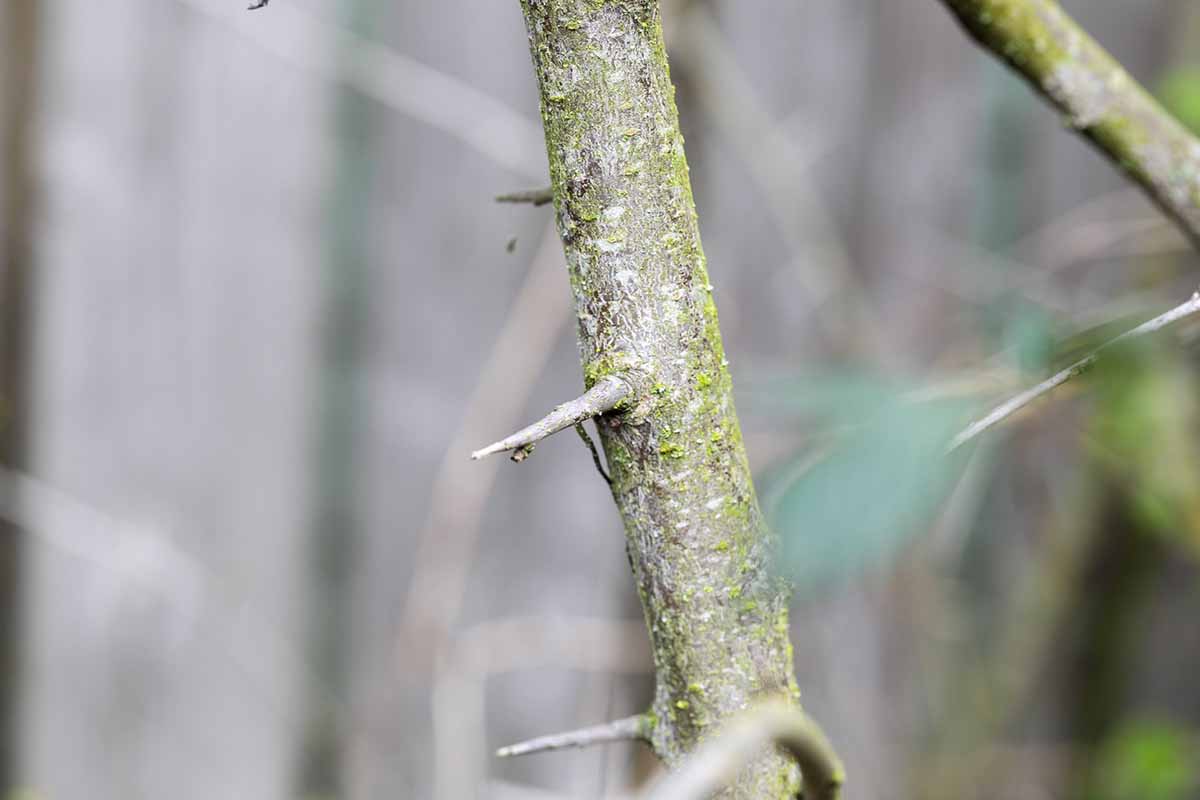
By the 1700s, it had become a well-recognized heart medication in Europe. And it was put to the same use in the US by the late 1800s.
Indigenous to China, C. pinnatifida (the Chinese hawthorn), C. hupehensis, and C. scabrifolia are rare outside of Asia and cultivated for their fruit in their native home.
While hawthorn is a popular garden plant in North America, it’s one of the most economically important plants in China, valued not only for its ornamental attributes but as medicine and food as well.
The azarole hawthorn (C. azarolus) is the most common in its native Mediterranean and Middle Eastern home, both commercially and in the wild.

Common or one-seeded (C. monogyna), woodland (C. laevigata), and two-seeded hawthorns (C. oxyacantha) are native to Europe. These became invasive in some areas after European immigrants brought them to North America.
All of these species have been extensively cultivated and are frequently found in nurseries and home gardens in the US and Europe.
C. nigra and C. pentagyna are also common in Europe and are cultivated for medicinal use, as are the other European species mentioned above.
As far as North American native species go, there are a lot to choose from. Some are uncommon in cultivation and others are gaining in popularity enough to compete with the European cultivars.
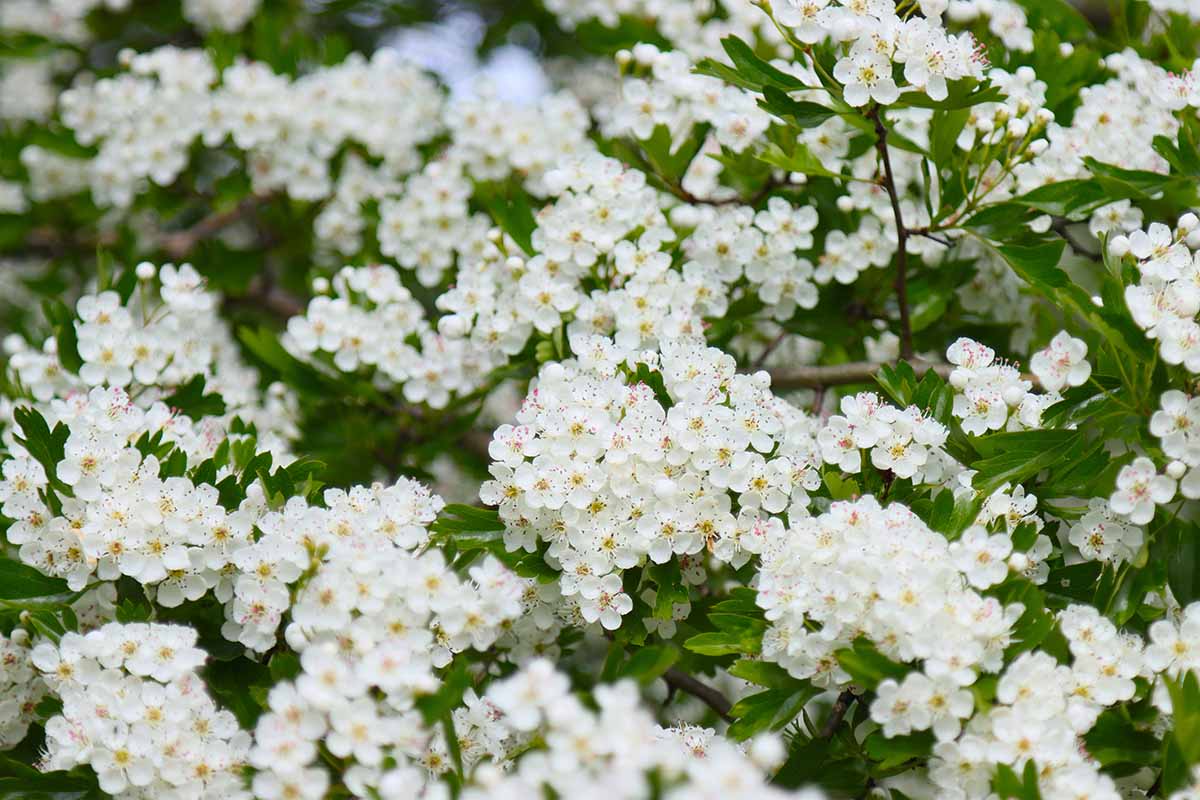
Indigenous people in North America knew a good thing when they saw it.
They had multiple uses for plants in the Crataegus genus, using hawthorn to treat “general debility,” bladder troubles, pain, upset stomachs, diarrhea, and mouth sores, as a laxative, and to stop menstrual flow, improve circulation, and improve appetite.
Topically, hawthorn was used to treat boils, ulcers, wounds, and arthritis. The thorns were used as needles and skin probes, as well as tines on herring rakes for non-medicinal use.
Today, these plants are primarily used by herbalists as a heart tonic, as all parts are mild vasodilators. Some people also use hawthorn as a memory aid, similar to Ginkgo biloba.
The pomes contain the anti-inflammatory and antithrombotic flavonol glycoside hyperoside, quercetin flavonoids, and the blood pressure-regulating amino acid tyramine.
The fruit also contains oligomeric and polymeric procyanidin compounds.
Hawthorn Tree Propagation
I know I did my best to get you all hyped up about hawthorns, but you aren’t in too much of a rush to enjoy them, right?
If you are, go ahead and skip directly to the section below on planting seedlings or transplants.
All the other propagation methods are slow going. Hawthorns just aren’t in a hurry, and you can’t be either.
Here we go, but not too quickly.
From Seed
With all those berries that form on the tree, it seems a waste not to try to plant a few and start more trees, right?
If you’re in a hurry, try a different method, since it can take at least five years before the seedlings reach more than a few feet tall and start to flower.
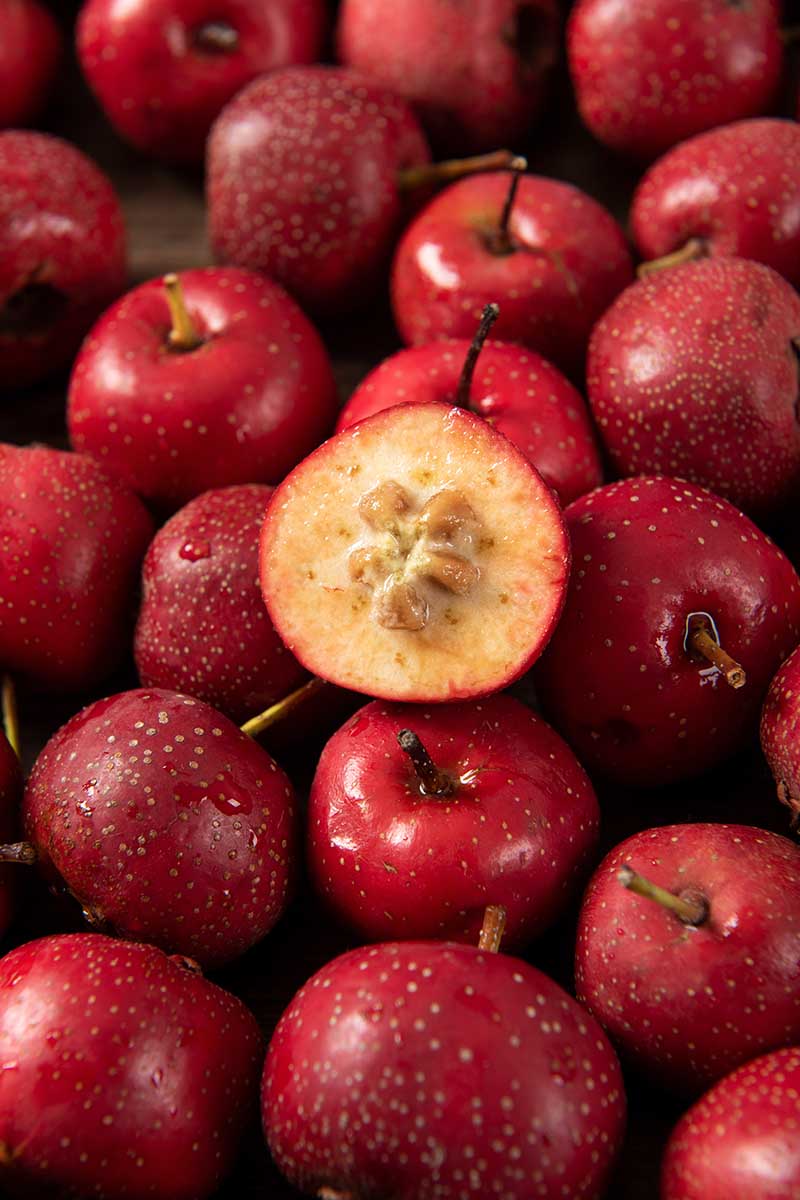
Seeds should be planted right away because they rapidly lose viability once they’re off the tree.
Wait until the fruits are fully ripe in the fall. They should be starting to wrinkle slightly. Pull them gently off the tree to avoid damaging the branches. Place them in a bucket and mash them up with a stick or other blunt object.
Don’t mash too hard or you’ll break the seeds. You want to create a pulpy mass, not a crunchy mess.
Pour water into the bucket and mix everything well with your hands, rubbing the pulp between them. You can wear gloves if you’re working with a particularly vibrant or juicy fruit, but most won’t stain your skin.
Let it sit for a few minutes, and then pour out most of the water and the floating debris. Rub the remaining seeds between your hands while holding them in the remaining water.
Fill the bucket with more water, swish it around, and dump the debris out again. You might need to do this several times to get rid of all the debris.
Once the seeds are clean, they’re ready to be placed in a tray filled with moist horticultural sand mixed with sphagnum moss in equal parts. The tray should have multiple drainage holes, so the seeds don’t drown. Make sure they’re covered with an inch of soil.
Place a screen over the tray to protect it from birds and squirrels, and place it outside in a protected spot. Now, your job is to keep the medium moist but not wet for the next 18 months.
In late winter or early spring of the second year, check the seeds. They should be starting to germinate. If roughly one in 10 is germinating, it’s time to plant.
Plant the seeds in prepared soil in the area where you intend to grow your tree. Poke each seed into the soil an inch deep and at least five feet apart.
Gently tamp down the soil and water well. Keep the soil moist and by summer, you should see a seedling popping up. Congrats! Keep the soil moist to support your new garden friend.
From Cuttings
It’s technically possible to grow hawthorns from cuttings, but this is not the best method because it’s unreliable.
Few cuttings will take, so you’ll want to start about six cuttings for each tree you want to grow.
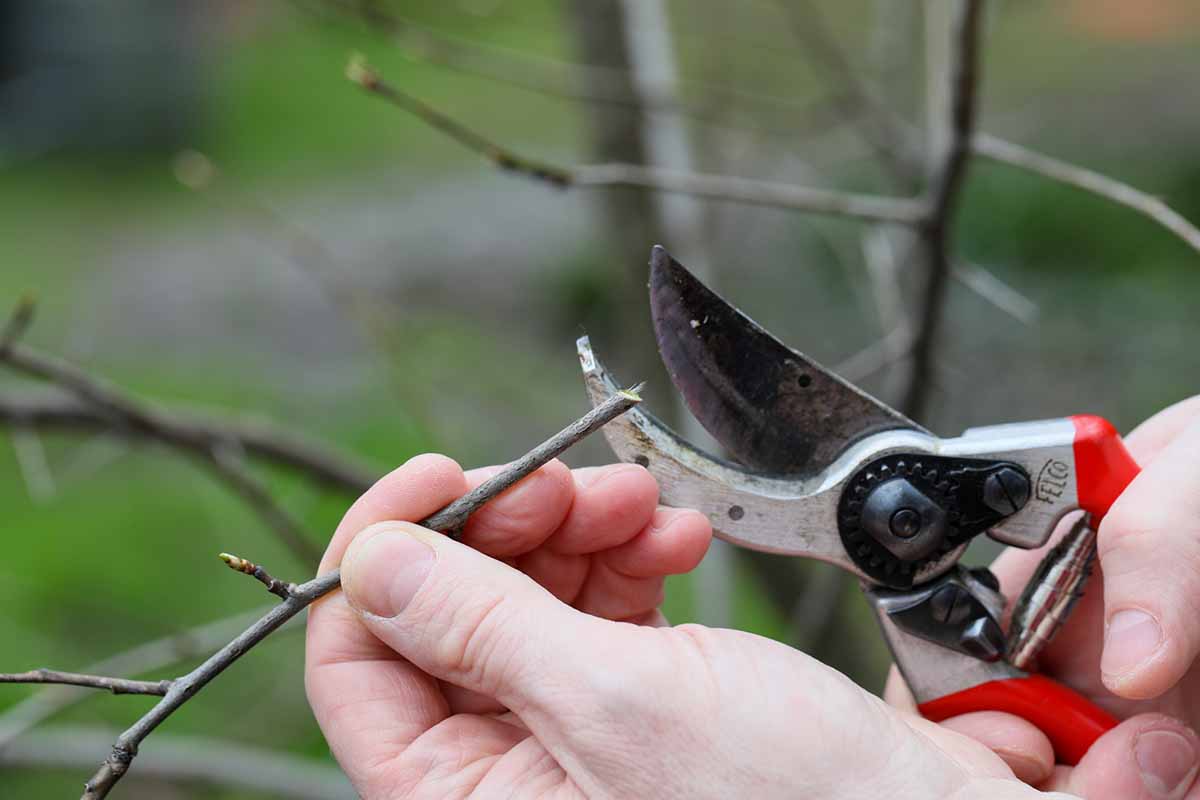
Take your cuttings in the spring just after the leaf buds have emerged. Look for a pliable end of a branch about six inches long.
Cut at a 45-degree angle, remove all but two of the leaf buds, and set the cutting in water until you’re ready to plant. Repeat as needed.
When your cuttings are ready, prep the planting area by amending the soil with well-rotted compost to ensure that it’s loose and rich.
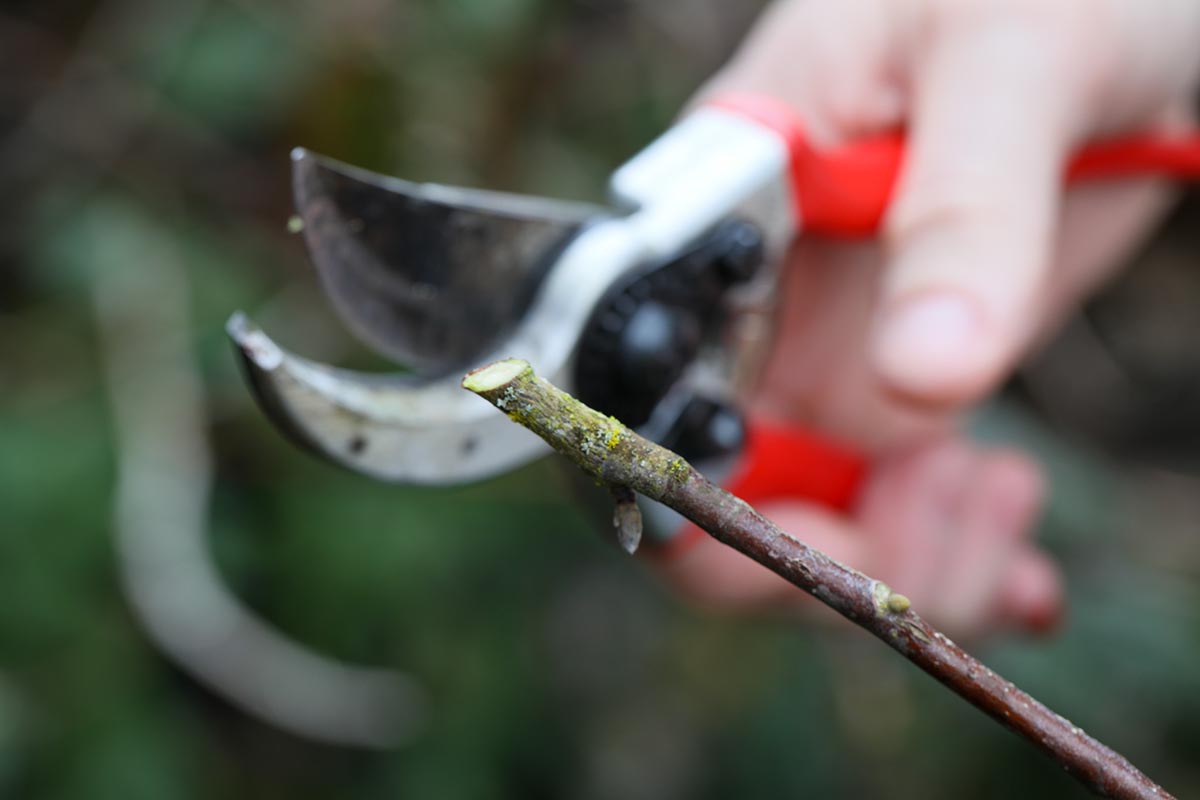
Dip the end of each cutting into a rooting hormone and poke a two-inch hole into the soil. Insert the cutting and firm the soil around it.
Remember, you need extra cuttings, so plant about six in each spot where you want a tree to grow, spaced about four inches apart. Water so the soil is moist but not wet, and keep it that way.
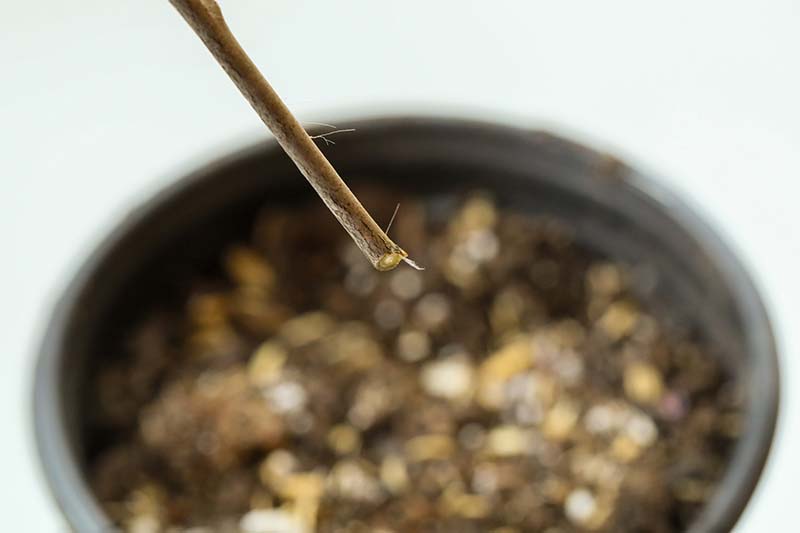
By the following spring, you should see new growth. Hopefully, at least one of the cuttings will have taken and you’ll see it bud out.
If so, give yourself a big pat on the back for your patience and persistence. If you have more than one cutting take, dig up the extras and move or dispose of them.
From Suckers
Some, but not all, hawthorns send out suckers. If you see little sucker volunteers popping up, you can move them to a different location to start a new tree.
This method is quicker and more reliable than taking cuttings, so if you want to nab a piece of a friend’s beautiful tree, this is the method I’d suggest.
Any tree grown on grafted rootstock shouldn’t be propagated this way unless you don’t care what the new tree looks like.
Typically, hawthorns aren’t grafted this way. Usually, hawthorn rootstock is used as the base for other trees like apple, pear, chokeberry, juneberry, quince, and medlars.
But some growers will graft hawthorns onto hawthorn rootstock, so look for a lump around the base of the tree – the graft point – to determine if yours is one of the rare ones.
Wait until you can see new active growth in the spring, and use a gardening fork to loosen up the soil around the suckers. Gently tilt up the roots and look for the part where the root of a sucker attaches to the parent plant. Sever this using clippers or a knife.
Cut back about half of the top growth using clippers, either by removing a few stems or some of the length.
Dig a hole large enough to accommodate the roots and plant the sucker in the ground at the same depth it was previously. Water well and keep the soil moist as the tree becomes established.
Air Layering
I like air layering because the new tree has some support while it’s developing, whereas cuttings are all on their own.
In the late winter, before the tree buds out, you’re going to remove a two-inch-wide strip of bark and cambium going all the way around a stem down to the lighter tan layer underneath.
You’ll need a sharp knife to do this. To make the cut clean, cut all the way around the circumference and then make a second cut two inches below that. Then, use the edge of the knife to scrape away the bark.
Grab some moistened sphagnum moss and wrap a two-inch-thick layer of moss all the way around the exposed bit. You might want to recruit a partner for this part because it’s a little hard to manage when you’re alone.
Hold the moss in place and wrap it with clear plastic wrap. Secure it in place with some twine, twist ties, wire, or tape. Wrap opaque plastic over this, and secure it in place as well.
Remove the outer wrapping occasionally to check for root growth and to see if the moss is drying out. If it is, open the top of the clear plastic and pour in some water.
If you see roots by the fall, it’s time to separate the rooted branch and transplant it. Just cut it right below the rooting area.
If there aren’t any roots, leave the wrap in place during the winter with an extra layer of cardboard or wool packed around it as insulation. If roots have formed by spring, remove and plant it. If not, it’s likely that the layering failed.
From Seedlings/Transplanting
Welcome, to all those with less patience or who opted to purchase a plant rather than propagating it using one of the methods described above!
Transplanting a hawthorn is pretty straightforward. To start, dig a hole twice the size of the container that the plant is growing in.
Unless you have extremely heavy or sandy soil, you won’t need to amend it. But poorly draining soil absolutely needs some well-rotted compost worked in.

Remove the plant from its container and loosen up those roots. Gently place the plant in the hole at the same depth it was at originally and fill in around the roots with soil.
Firm it up and add water. Some of the soil will probably settle, and if that’s the case, just add a bit more.
Add an inch-thick layer of organic mulch like hardwood shavings or leaf litter to protect the youngster from weedy competition.
If you’re planning to grow a living fence, space the trees about 10 feet apart.
How to Grow Hawthorn Trees
As evidenced by their ability to grow in a wide range of environments, hawthorns are adaptable.
Any kind of soil from moderately chalky or sandy to moderately clayey is fine. They can even tolerate poorly draining soil, though well-draining soil is ideal.
They can tolerate heavy winds, so if you have a spot that is constantly buffeted, hawthorns are about to be your new best friends. They can even handle salty wind in maritime environments and pollution in cityscapes.

Of course, if you’re growing yours to use the fruit, bark, and flowers as food or medicine, avoid heavily polluted positions like those along roadways.
Full sun is best, particularly for fruit production, but partial sun is fine. Partial shade will be tolerated, but you’re going to lose some flowering and fruit production.
Beyond sun and soil considerations, you might want to avoid planting anywhere that kids or pets play. You don’t want them getting snagged on the thorns.
Once a year in the spring, apply an all-purpose, balanced fertilizer unless a soil test suggests you need to add more of a certain element or leave something out.
Southern Ag’s All Purpose Granular Fertilizer will do the job.

Southern Ag All Purpose Granular Fertilizer
Grab some at Amazon in a five-pound bag
Growing Tips
- Suitable for full sun, in a variety of soil types.
- Don’t plant where kids will want to climb or play, or select a thornless type.
- Fertilize once in the spring.
Pruning and Maintenance
Pruning isn’t required except to remove any branches that are dead, diseased, or deformed.
Deformed growth includes branches that are rubbing together or that just grow in a funky direction that detracts from the look of the tree.
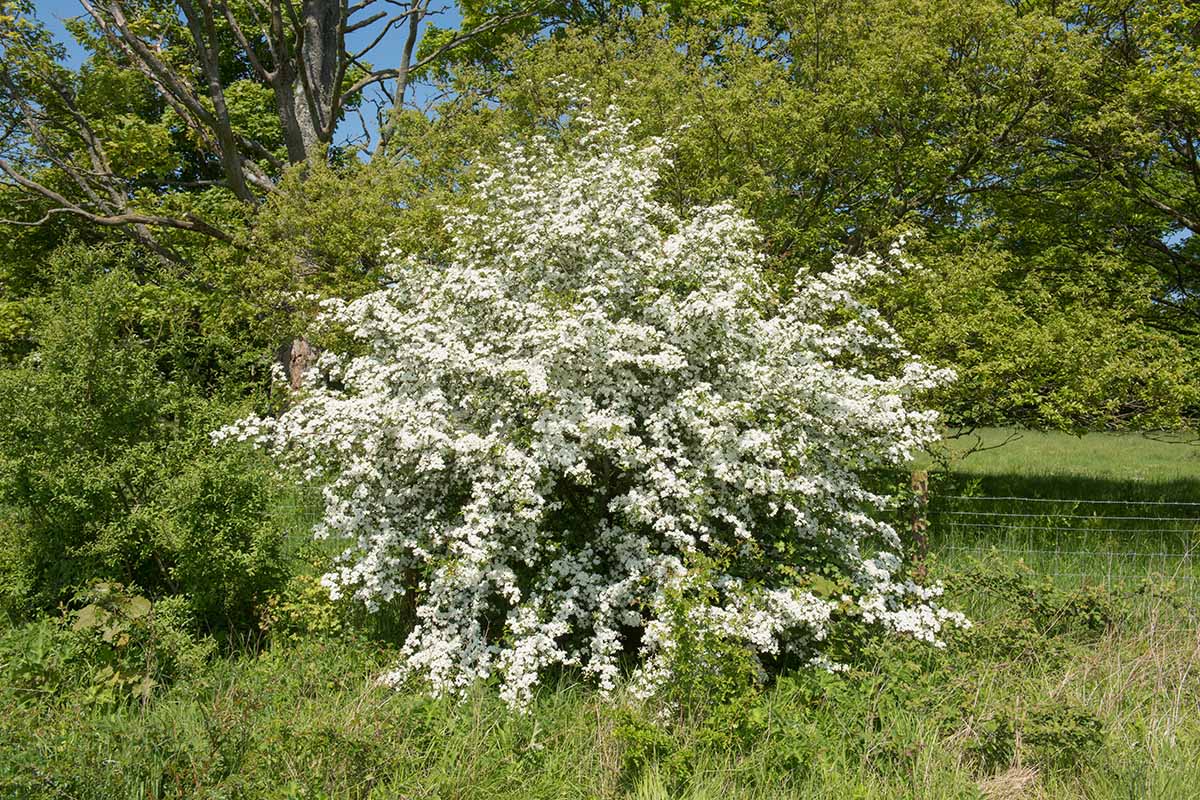
When you cut, put on a metal suit of armor, including a face shield and gauntlets.
If you don’t keep your medieval armory well stocked, you should wear thick rubber or leather gloves and several layers of thick clothing over your arms and torso.
I’d even recommend safety goggles. I have a scar near my eye from a time when I was harvesting pomes and a thorn caught me. Those thorns are no joke.
When they stab into your skin, they can break off and embed themselves, and they can be hard to remove. A thorn that stays in your skin can become infected or even septic. Best to avoid them altogether rather than having to deal with them.
Use a sharp pair of pruners or a small saw and cut back to the next branch or trunk.
When the trees are young, you can remove all but one trunk or central leader and remove the lower branches to encourage a more tree-like rather than shrub-like shape.
For the first few years, replenish the mulch layer every few months to suppress those weeds. After that, you can leave the tree to its own devices.
Hawthorn Species and Cultivars to Select
As you can imagine with a genus that contains so many species and hybrids and that has been cultivated for so long, there are many, many cultivars out there, and new ones popping up all the time.
It never hurts to chat with the employees at your local nursery to see what they recommend for your area, but these adaptable plants can settle in just about anywhere.
Here are some notable options:
Crusader
A popular cockspur (C. crus-galli) cultivar, ‘Crusader’ is extremely floriferous with lots of white blossoms and persistent red berries, all on a tree that tops out at just 15 feet.
It has a pleasantly rounded shape and a dense growth habit.
Pick up one of these thornless trees at Fast Growing Trees.
Jubilee
‘Jubilee’ is a fleshy (C. succulenta) cultivar bred in the Netherlands that forms plump, somewhat juicy (rather than mealy) fruits.
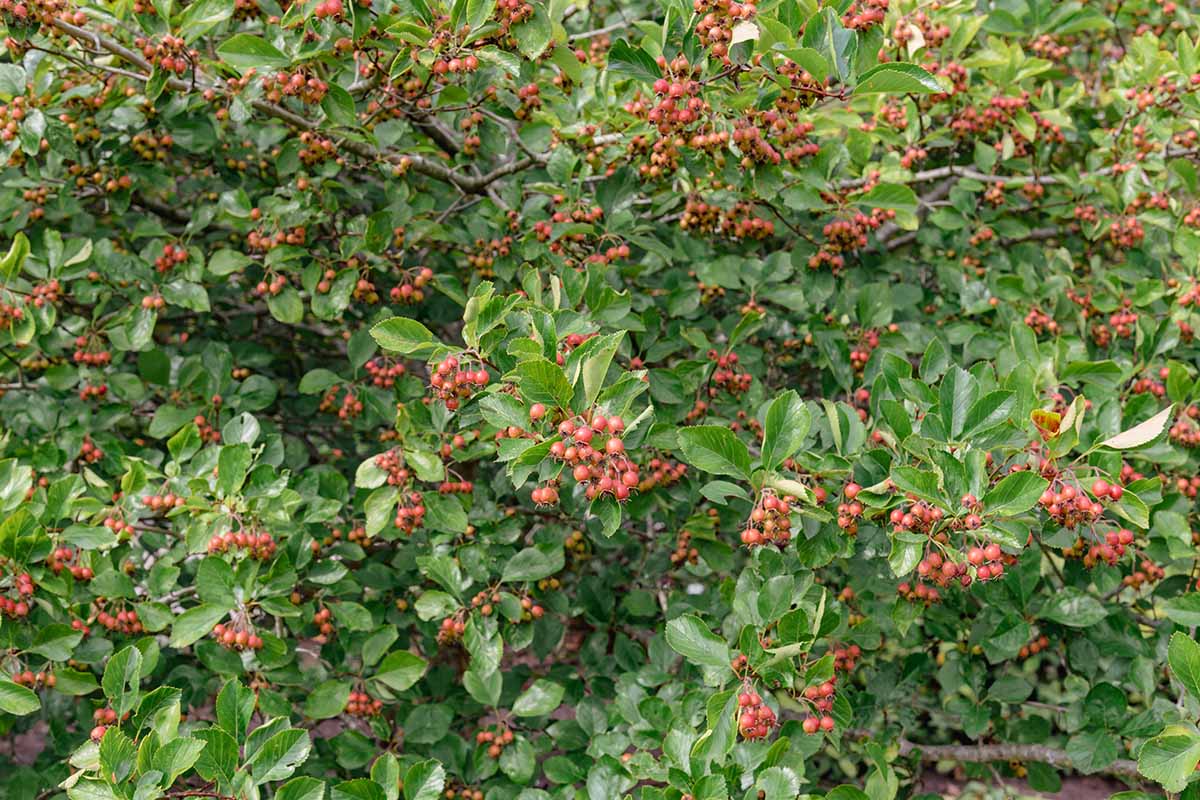
It has a dense, rounded crown on a single or multi-stemmed plant that can reach 25 feet. It’s resistant to fire blight and rust.
Vaughn
‘Vaughn’ is a hybrid cross between C. phaenopyrum and C. crus-galli that brings large fruits and flowers with exceptionally glossy leaves to the table.
It’s largely thornless and has an extremely upright growth habit.
Washington
The Washington species, C. phaenopyrum, has become popular as an ornamental because it’s a late bloomer, dodging all those late frosts, and has particularly vibrant foliage in both the spring and fall.
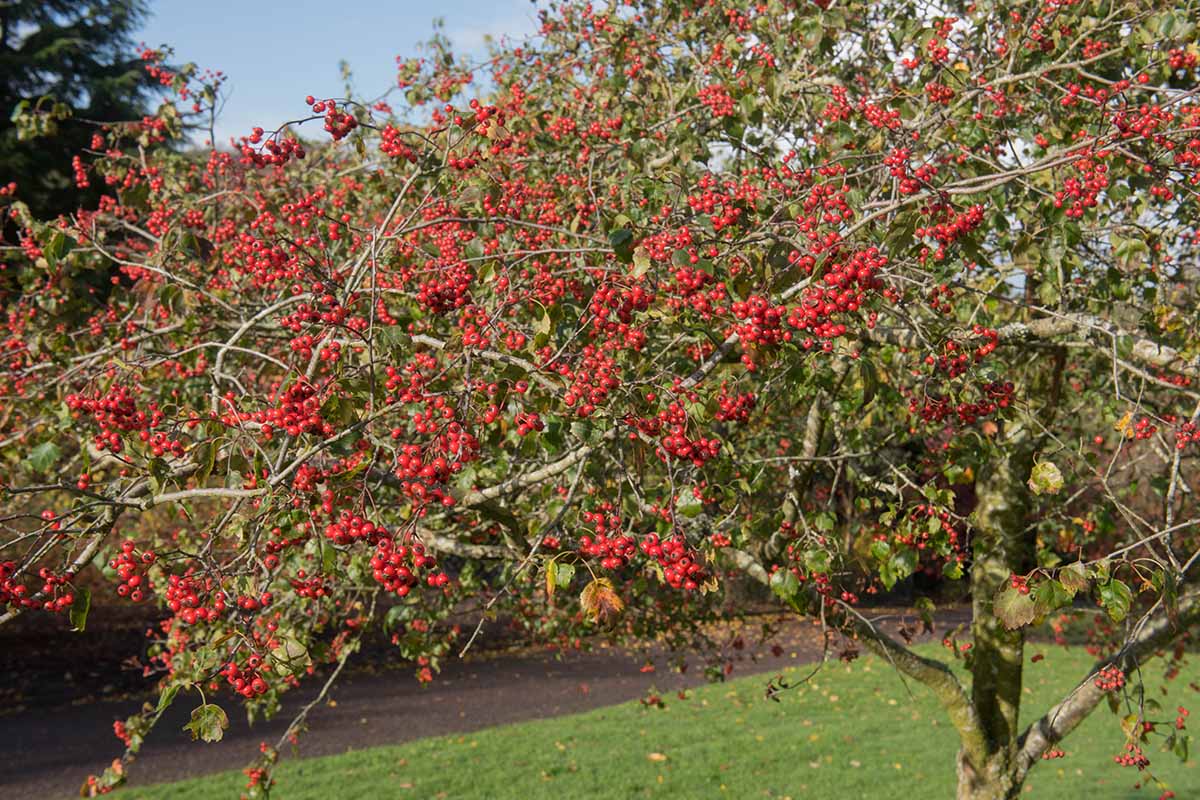
As the leaves emerge, they’re reddish-purple before transitioning to a deep green for the summer.
With the changing seasons, the leaves shift again, this time to a vibrant array of orange, crimson, magenta, and purple.
Nature Hills Nursery carries live plants in #1 containers.
Winter King
Beautiful ‘Winter King’ is a C. viridis cultivar with white blossoms and extremely large fruits.
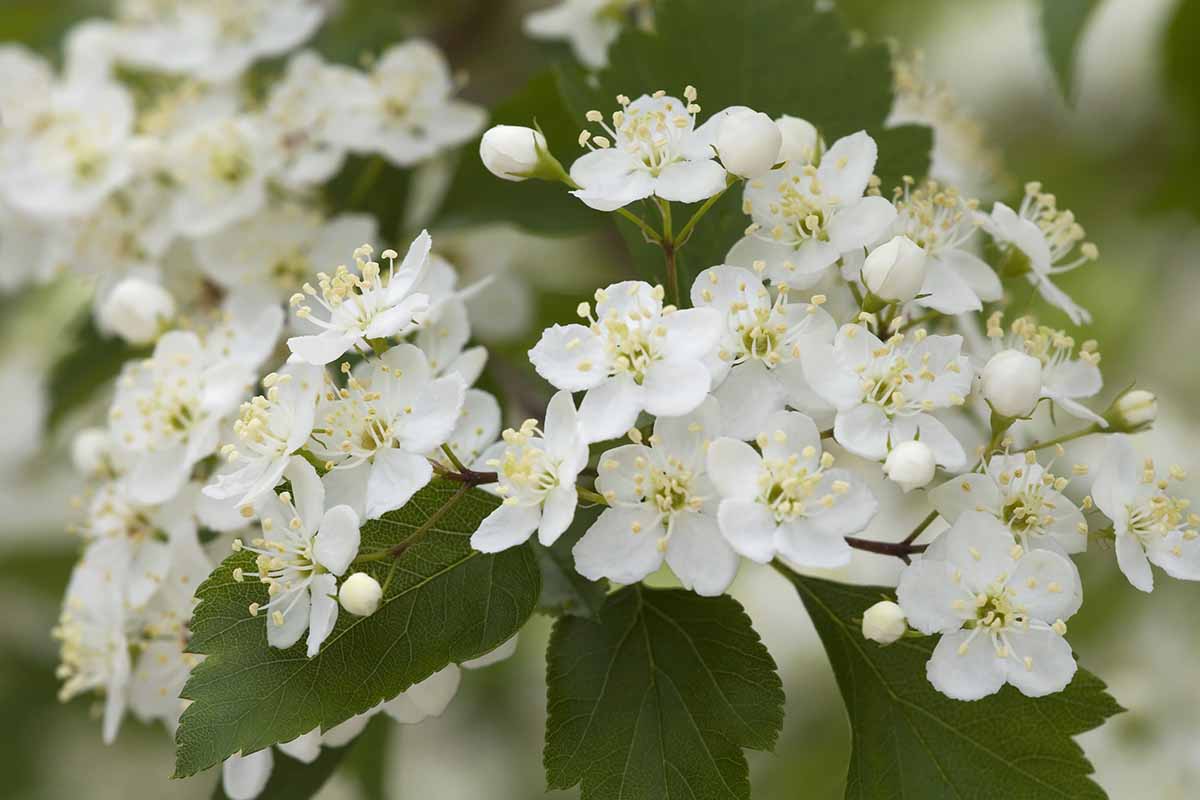
But what makes it truly fabulous is that it resists fungal diseases and is nearly thornless.
Managing Pests and Disease
Before we jump into this section, I’m giving you a heads up: You’ll probably never encounter any of these issues. Hawthorns are tough.
Don’t feel like you failed or did something wrong if any pests or diseases come visiting, though. So long as you planted in the right conditions, sometimes it’s just the (bad) luck of the draw.
Non-native types tend to be more prone to issues, and you might encounter powdery mildew or apple scab. These are less common on types grown in their native environment.
Insects
There are just two common insects to watch for, and neither requires any sort of chemical control.
When they’re present, it could be a sign that you need to work on creating a healthy garden environment, with plenty of plants that attract beneficial predators.
Hawthorn Leaf Miners
Hawthorn leaf miners (Profenusa canadensis) are probably the most common pests you’ll see.
These tiny larvae of sawflies chomp tunnels through the leaves of plants during the late spring.
The result is unsightly leaves with trails throughout and dead, brown tips. These leaves tend to be more susceptible to further damage from drought and frost.
As new growth emerges after the larvae pupate and take off, the tree will recover and continue on its merry way for the rest of the year. As a result, you really don’t need to treat infestations.
Avoid planting C. crus-galli, C. persimillis, and C. erecta if you find infested leaves to be bothersome. These species are particularly susceptible.
Woolly Aphids
Woolly apple aphids (Eriosoma lanigerum) look like a symptom of fungal infection or mealybugs, but they’re basically just those old familiar aphids we know and love, with a fluffy coat on.
To be perfectly honest, they look scarier than they are. They don’t really do much damage to trees, and they’re usually limited by myriad natural predators.
Trying to eliminate them isn’t suggested, since a lot of the methods of controlling aphids can harm beneficial insects. Your best bet is to just keep your tree and the surrounding garden healthy.
You can learn more about woolly aphids in our guide.
Disease
Fungal pathogens are the main cause of hawthorn diseases. There are two common ones that you should be aware of:
Cedar Hawthorn Rust
If you’ve ever heard of or dealt with cedar apple rust, this is the same thing, just with a hawthorn tree instead of an apple.
It’s caused by Gymnosporangium globosum, which results in yellow spots on the leaves, and the pomes may have orange fungal growths on them.
Dealing with it is the same as with other cedar rusts – learn more in our guide.
Fire Blight
Many plants in the Rosaceae family are prone to fire blight, and while hawthorns aren’t extremely susceptible, it isn’t unheard of.
It causes shoots, leaves, and fruits to turn black and necrotic.
Sadly, if you’re one of the unlucky few, you’ll need to pull up your plant and get rid of it by burning or via disposal. Otherwise, you risk further spread to other plants.
Best Uses for Hawthorn Trees
Whether you choose to eat the fruit or just grow your hawthorn as an ornamental, these plants have many uses.

The “haw” in hawthorn is Anglo-Saxon for “hedge,” and that’s what people in England used this plant for. Imagine trying to push your way through a thick hedge of hawthorns. You’d have to be really determined to try it.
In fact, that’s part of why the plants spread out of their native ranges.
European farmers brought their native hawthorns with them to plant as livestock fencing in America, New Zealand, and Australia. They quickly escaped cultivation and have made themselves at home wherever they were taken.
Having said that, if you want to create natural fences for livestock or just to keep out nosy neighbors with a defensive barrier, choose shorter, shrubby options and plant them close together.
If you want to attract native pollinators, choose native species. These are smart options to plant in your garden.
If you choose to eat the fruit, don’t eat the seeds. Cook the berries and remove the seeds or peel the flesh away from the seeds.
A few certainly won’t hurt you, and many a forager has chomped through them while out wandering, myself included.
But the seeds contain a compound of cyanide bonded with sucrose called amygdalin, which is released when the seeds are crushed. When you eat something containing this compound, it turns to hydrogen cyanide in your small intestine.
If you’ve ever studied up on your poisons, then you know that enough of this chemical can kill you.
Apples contain the same compound in their seeds, as do rose hips, peaches, and other fruits in the Rosaceae family. For the average 150-pound human, that would mean eating over 70 hawthorn seeds at a go.
Some species, like C. monogyna, have only one seed, which you can easily remove. This type of berry can be eaten raw. But it’s too difficult to remove them from fruits with multiple seeds, so they need to be cooked to facilitate seed removal.
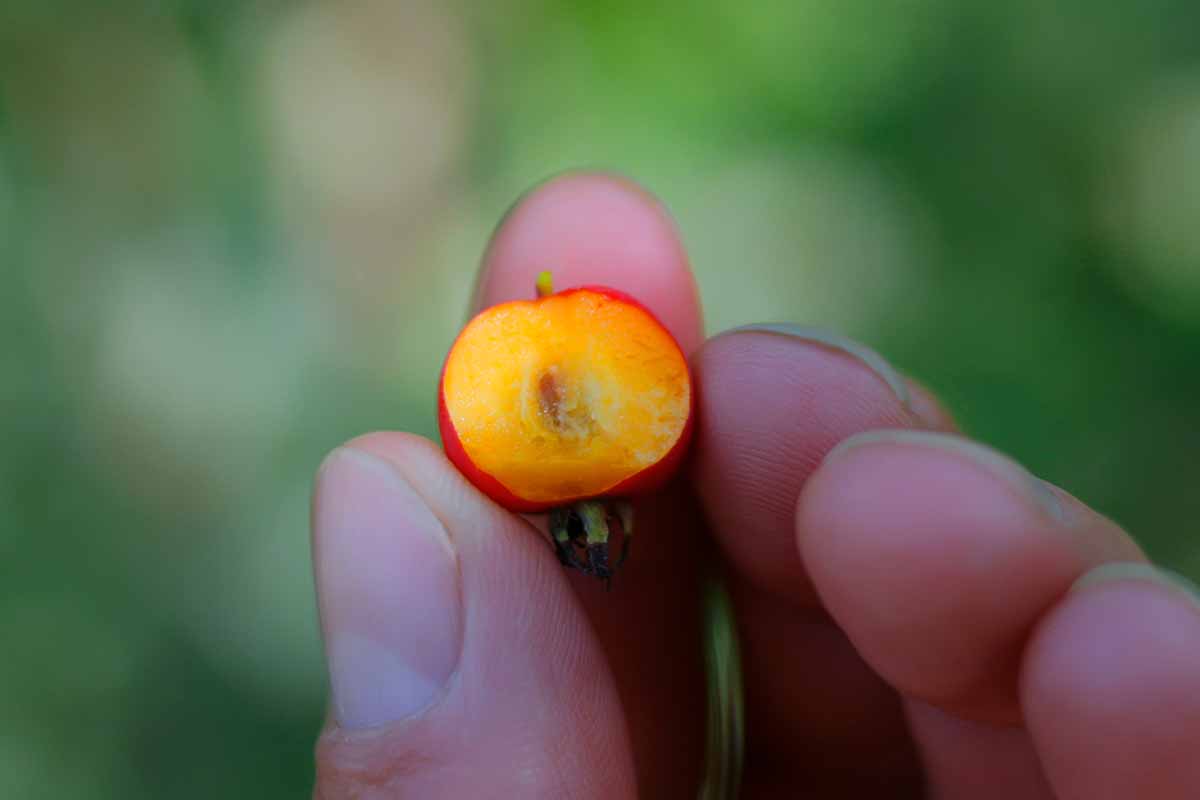
It’s super difficult to eat the seeds anyway, because they’re hard as a rock. I’d imagine you’d break a few teeth before you could eat enough to do yourself real harm, but let’s not go testing the theory, okay?
The berries are high in pectin, so they naturally lend themselves to jelly-making.
All species are edible (minus the seeds), but not all are delicious (although the wildlife will appreciate them). It’s best to taste yours and decide whether the flavor is to your liking before you dive into a complicated recipe.
Foragers will munch on the berries as they explore the woods, and with one bite, you’ll quickly realize how much pectin there is. The juice rapidly takes on a jelly-like consistency the minute you squeeze it out of the drupe.
C. azarolus, C. mexicana, C. pinnatifida, and C. scabrifolia are all cultivated as fruit trees. But Cerros (C. erythropoda), on the other hand, has hardly enough flesh to bother with.
Dried berries can last for years, and the dried flowers and leaves, which make a lovely tea, can last for up to a year. Store them in a cool, dry, dark spot.
All of these can be dried by spreading them out on screens in a dry area out of direct sunlight.
Agitate the berries now and then to move them around and expose them to the air. You can also dry them in your oven on the lowest setting, or in a dehydrator.
Freeze the berries by removing any damaged ones, rinsing them in water, drying them completely, and placing them in a sealed container in the refrigerator. They can last this way for up to six months.
The pomes become a bit more mealy and squishy, as well as a bit sweeter, after a freeze.
It can be a treat when you head outside in the winter and stumble across some that the birds missed. Just don’t try to dry or freeze any that have already been frozen. They don’t keep well.
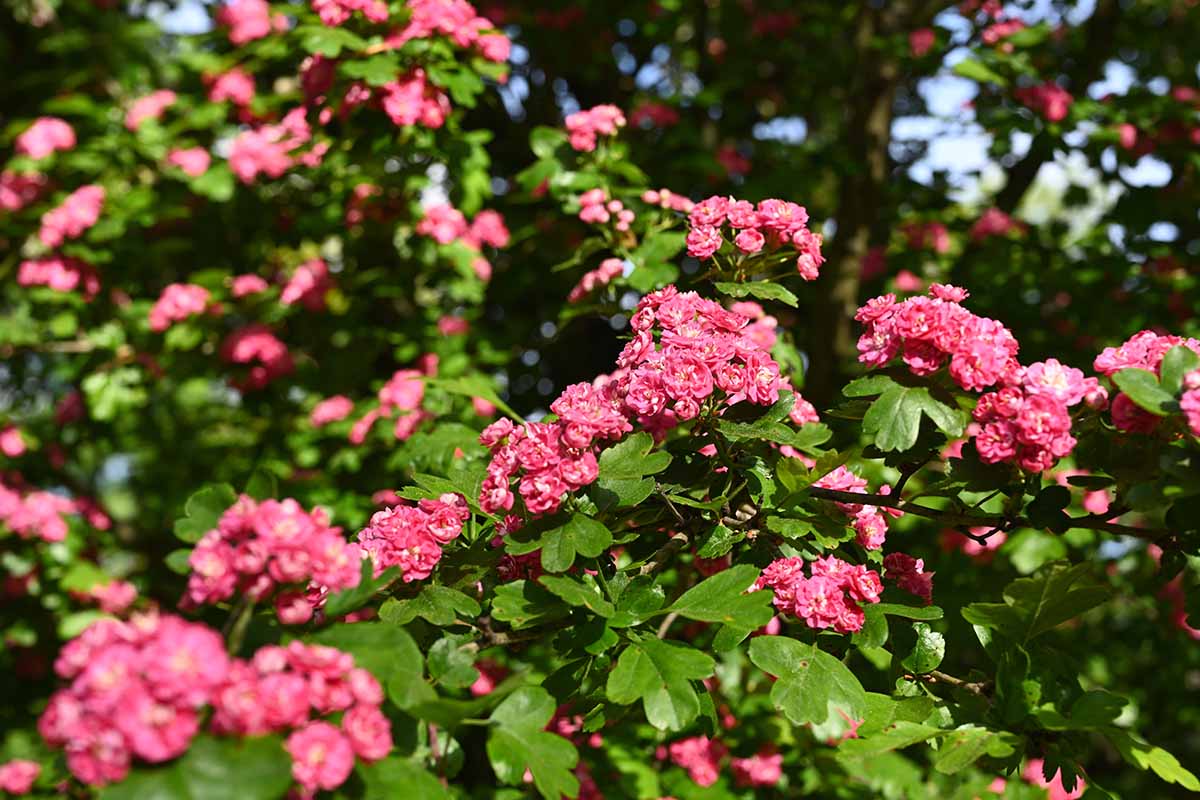
In western medicine, C. laevigata and C. monogyna are most commonly used. In Chinese medicine, it’s C. pinnatifida that takes all the glory.
If you want to make a medicinal decoction, the standard method is to boil the inner bark, thorns, leaves, berries (minus the seeds), or flowers in water until it reduces by one-quarter.
Four to eight ounces of the standard decoction can be taken three times per day, according to “The Modern Herbal Dispensatory: A Medicine-Making Guide” by Thomas Easley and Steven Horne.

The Modern Herbal Dispensatory: A Medicine-Making Guide
Copies of this book are available on Amazon.
The leaves and flowers should be simmered for five minutes in water just below the boiling point.
If you have any desire to forage and eat wild foods, “Forage: Wild Plants to Gather, Cook, and Eat” by Liz Knight is an indispensable book.

Forage: Wild Plants to Gather, Cook, and Eat
Knight includes fantastic recipes for hawthorn flower syrup, berry marinade, and a gremolata made with the leaves.
Pick up a copy at Amazon.
Quick Reference Growing Guide
| Plant Type: | Perennial tree | Flower/Foliage Color: | White, pink, red/green |
| Native to: | Temperate East Asia, Europe, North America | Maintenance: | Low |
| Hardiness (USDA Zones): | 3-9 | Tolerance: | Drought |
| Bloom Time: | Spring/fall | Soil Type: | Loamy; moderately clayey/sandy/chalky |
| Exposure: | Full sun or partial shade | Soil pH: | 6.0-7.5 |
| Time to Maturity: | 30 years | Soil Drainage: | Moderate to well-draining |
| Spacing: | 10 feet | Attracts: | Butterflies, carpenter bees, mining bees, honey bees, ladybugs, flower beetles, bee flies, syrphid flies, ichneumon wasps, muscid flies, assassin bugs, wasps |
| Planting Depth: | 1 inch (seeds), same depth as container (transplants) | Companion Planting: | Apples, crabapples, cotoneaster, peaches, pears |
| Height: | 30 feet | Avoid Planting With: | Cedar, juniper |
| Spread: | 25 feet | Uses: | Specimen, bonsai, hedge, medicinal, edible |
| Growth Rate: | Slow | Family: | Rosaceae |
| Water Needs: | Moderate | Genus: | Crataegus |
| Common Pests: | Hawthorn leaf miners, woolly aphids; Cedar hawthorn rust, fire blight | Species: | Aestivalis, anomala, arnoldiana, azarolus, calpodendron, canadensis, castlegarensis, chysocarpa, coccinea, coccinioides, columbiana, crus-galli, dispessa, douglasii, enderbyensis, erythropoda, flava, greggiana, hupehensis, intricata, laevigata, macracantha, marshallii, mexicana, mollis, monogyna, nigra, okanaganensis, okennonii, opaca, oxyacantha, pentagyna, phaenopyrum, phippsii, pinnatifida, pringlei, pruinosa, pulcherrima, punctata, reverchonii, rivularis, saligna, scabrifolia, spathulata, submollis, succulenta, suksdorfii, tracyi, turnerorum, uniflora, viridis, wootoniana |
Embrace Life’s Thorns
Hawthorns are tough, adaptable, and resilient, but it’s not just about being survivors when it comes to these plants.

They’re beautiful, too, with a blanket of flowers in the spring, colorful foliage in the fall, and bright red fruits that can last through the winter.
They’re edible and can be used medicinally. All the pluses make it worth embracing or even putting the thorns to work for you.
Of course, there are thornless options, too. These trees really can do it all.
What species do you plan to grow? How will you use it? Share with us in the comments section below.
No doubt you’re going to plant other things in your garden, right? If you want more ornamental tree options, you might find these guides useful:
